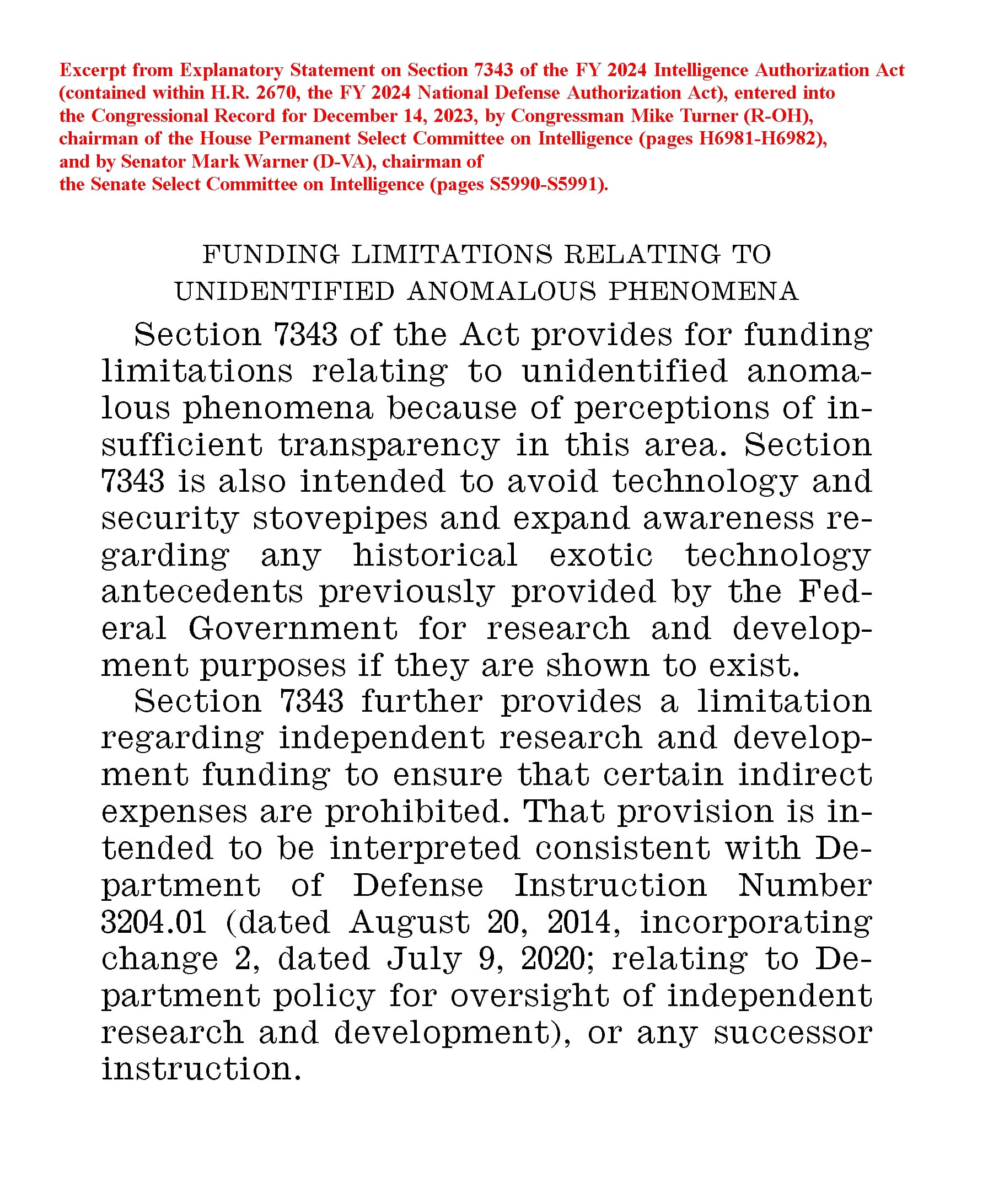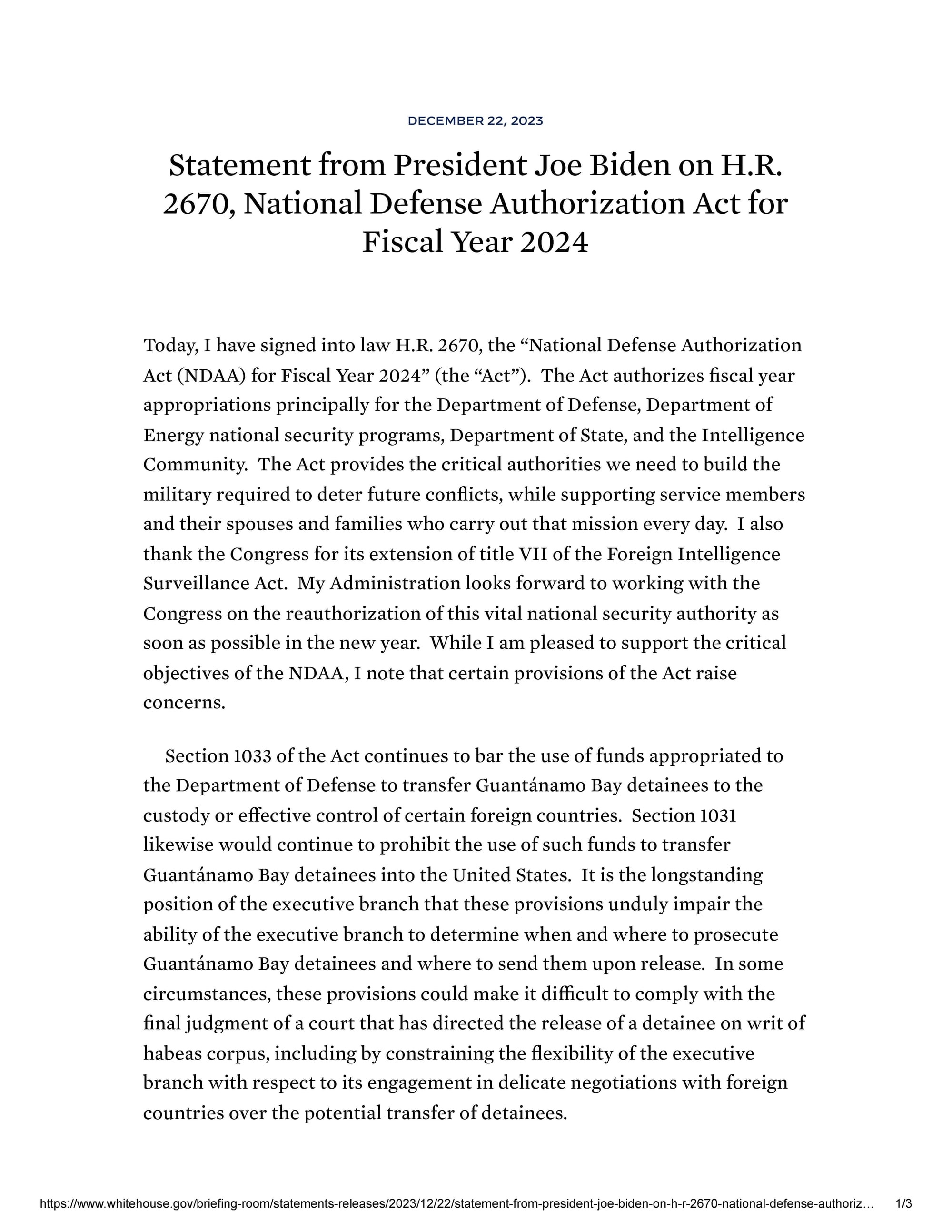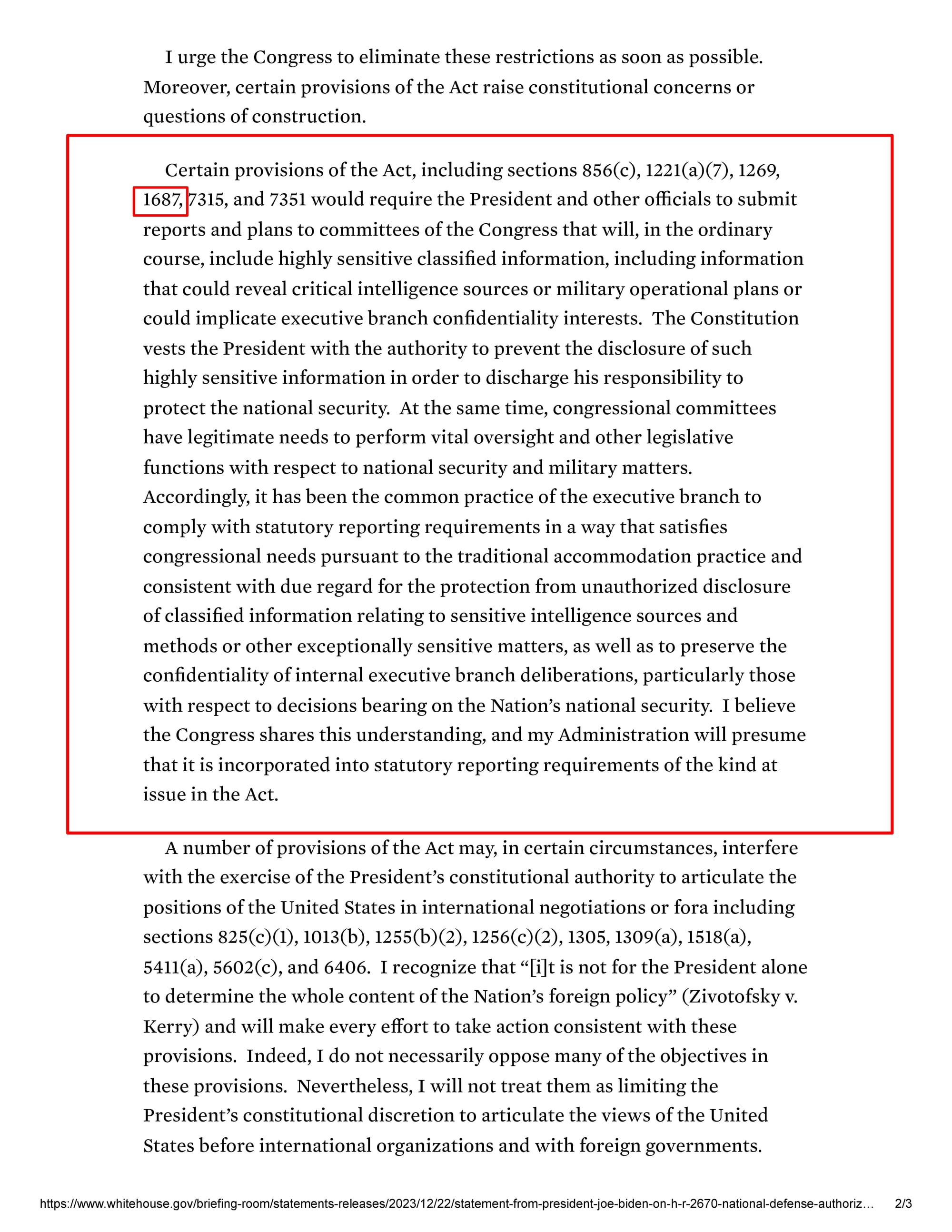Quick guide to UAP-related provisions in the final FY 2024 National Defense Authorization Act

By Douglas Dean Johnson
@ddeanjohnson on X/Twitter
Originally posted: December 13, 2023. Latest update: December 22, 2023, 4:50 PM EST. A log of substantive changes/updates after initial publication appears at the bottom of this article. My gmail: full name as above.
On December 22, 2023, President Biden signed into law the FY 2024 National Defense Authorization Act (NDAA, H.R. 2670).
The just-signed NDAA contains four provisions relating to Unidentified Anomalous Phenomena (UAP)– three of these substantive, and one merely a minor adjustment pertaining to an annual report. In a formal signing statement, President Biden listed one of the act's UAP-related provisions, Section 1687, as among several provisions of the act that would require submission of "highly sensitive classified information" to Congress, and said that the Administration will presume a right to comply with these provisions in a manner (not specified) that it believes protects national security. Section 1687 and the signing-statement paragraph dealing with it are described in more detail below.
H.R. 2670 in its final formatting ("enrolled bill") is 973 pages long. It authorizes $886 billion in defense and intelligence programs (this year's NDAA incorporates the Intelligence Authorization Act)[2]. The U.S. Senate approved the final, unamendable version H.R. 2670 on December 13, 2023, by a vote of 87-13. The U.S. House of Representatives passed it on December 14, 2023, by a vote of 310-118.
An earlier version of the NDAA passed by the Senate on July 27, 2023 contained UAP-related language that was much more expansive, but much of it was either eliminated or greatly toned down in a House-Senate conference committee, which issued the final melded bill on December 6. For details on the array of UAP-related provisions that had been approved earlier in 2023 by the Senate, by the House, and/or by specific congressional committees, please see my articles "Senate Intelligence bill gives holders of 'non-earth origin or exotic UAP material' six months to make it available to AARO" (June 24, 2023) and "Quick guide to UAP-related provisions currently under consideration in Congress" (September 3, 2023), and the documents appended to those earlier articles. This article does not analyze in detail the extensive changes to the UAP-related provisions that were made in the House-Senate conference committee, or discuss the possible reasons for those outcomes, but merely provides a quick guide to assist in navigation of the final products of this year's legislative process.
I prepared a PDF document, embedded below, that contains all of the UAP-related pages of the FY 2024 NDAA after final approval by Congress. (The bill as later signed by the President is formatted differently and has different pagination, but the text is the same.) Also included in this PDF are the UAP-relevant pages from the Joint Explanatory Statement (JES) of the House-Senate conference committee. The JES is not a document that will be signed into law by the President, but it does carry some weight: Executive Branch agencies generally defer to such "report language" as expressing the intent and will of Congress, and usually comply with any directive language in such documents, more or less. In this PDF document, the bill language--what the President ultimately will sign into law--appears in italics. The JES language appears mostly in regular roman typeface.
If you have any difficulty downloading the embedded document above, it can also be downloaded from this link.
On December 14, 2023, the chairmen of the Intelligence committees of the House and Senate entered into the Congressional Record a separate Explanatory Statement, with explanations and directives relating only to the Intelligence Authorization Act (IAA) portion of H.R. 2670 (Division G). The portion of that Explanatory Statement that is pertinent to UAP may be found near the bottom of this article.
Referring to the embedded PDF document, the UAP-related provisions are as follows:
Section 1687 (pages 489-490 of H.R. 2670): LIMITATION ON THE USE OF FUNDS FOR CERTAIN UNREPORTED PROGRAMS. This section denies funding for Department of Defense special access programs "involving" UAP "unless the Secretary of Defense has provided the details of the activity to the appropriate congressional committees and congressional leadership..." It also states that such research is not allowable as "indirect expenses" under "independent research and development" funding, "unless such material and information is made available [to] the appropriate congressional committees and congressional leadership."
[UPDATE: In a formal signing statement issued when he signed the NDAA into law on December 22, 2023, President Biden listed Section 1687 as among several provisions of the act that would require submission of "highly sensitive classified information" to Congress. The President said that the Administration will presume a right to comply with these provisions in a manner that it believes protects national security; the signing statement did not specify the nature of those adjustments. Images of the President's complete signing statement appear at the bottom of this article under End Note [4].]
Sections 1841-1843 (pages 568-575): UNIDENTIFIED ANOMALOUS PHENOMENA: These sections contain the remnants of the much more expansive UAP Disclosure Act (Schumer-Rounds Amendment) that had been included in the earlier Senate-passed version of NDAA. The final bill text requires the Archivist of the United States to form a collection of documents from throughout the government (both classified and unclassified) that "pertain to unidentified anomalous phenomena, technologies of unknown origin, and non-human intelligence." (None of these terms are defined in the bill or in the JES; the Archivist presumably will have to come up with working definitions, and on a short time frame.) The bill provides for the release of some records, but the continued withholding of other records at the discretion of the individual agencies. All of the covered records are to be released 25 years after creation, except cases in which the President certifies that continued withholding is necessary to prevent harm to military defense, intelligence operations, law enforcement, or conduct of foreign relations.
Section 7003 (page 901): EXPLANATORY STATEMENT ON INTELLIGENCE AUTHORIZATION ACT: This section says that a forthcoming joint statement by the chairmen of the Intelligence Committees will carry the same directive authority, with respect to the Intelligence Authorization Act (which is included in H.R. 2670 as Division G), as the Joint Explanatory Statement holds with respect to the rest of the bill. [UPDATE: The two Intelligence committee chairmen entered their Explanatory Statement into the Congressional Record of December 14, 2023. It contained two paragraphs discussing the UAP-related Section 7343 of H.R. 2670; that portion of their Explanatory Statement is reproduced near the end of this article.]
Section 7341 (page 943): MODIFICATION OF REPORTING REQUIREMENT FOR ALL-DOMAIN ANOMALY RESOLUTION OFFICE. This section provides that in the future, the annual-summary UAP reports (unclassified/classified), already required by previously enacted laws, will be released/submitted to Congress by the All-Domain Anomaly Resolution Office (AARO) and its director, rather than the Secretary of Defense and the Director of National Intelligence.
Section 7343 (pages 944-945): FUNDING LIMITATIONS RELATING TO UNIDENTIFIED ANOMALOUS PHENOMENA: This section denies funding for restricted access programs funded through authorizations provided under the Intelligence Authorization Act "involving" UAP "unless the Director of National Intelligence has provided the details of the activity to the appropriate congressional committees and congressional leadership..." It also says that such research cannot be funded as "independent research and development...indirect expenses...unless such material and information is made available to the appropriate congressional committees and leadership." This section largely mirrors Section 1687, but it applies to programs created under different authorities and with different funding streams.
The UAP-related passages found in the Joint Explanatory Statement (JES) are as follows (the page numbers referred to here are from the report of the House-Senate conference committee, Report 118-301):
JES page 1205: The conference committee notes that it dropped the House-passed provision [Burchett Amendment], which would have told the Department of Defense to release classified records dealing with "publicly known [UAP] sightings" unless the agency thought there was a national security reason to decline to release them. [3]
JES pages 1311-1312: These pages contain explanatory material on bill Section 1687 (the Department of Defense funding restriction), noting that the conference committee removed the Senate-passed requirement that UAP-related special-access programs provide certain UAP-related information and materials to the All-Domain Anomaly Resolution Office (AARO). The JES notes that as finalized, Section 1687 "could cover" a list of specific types of activities, including "analyzing such craft, or pieces of components thereof..." and "actions relating to reverse engineering or replicating unidentified anomalous phenomena technology or performance..."
JES page 1330: This pertains to bill Sections 1841-1843, tersely summarizing the changes made by the conference committee in the Senate-passed UAP Disclosure Act (Schumer-Rounds Amendment), including the removal of "the [Senate-passed] provisions that would establish an independent Review Board, a Review Board staff, eminent domain authority, or a controlled disclosure process." [Also found here is a paragraph expressing concerns about "lack of sufficient reciprocal access between Department of Defense and intelligence community personnel [that] has led to operational inefficiencies and unnecessary risk of disclosures of protected information," and requiring briefings to the congressional armed services and intelligence committees on such issues; it is unclear to me what perceived problem is being discussed here.]
The UAP-related paragraphs of the Explanatory Statement of the Chairmen of the Intelligence committees of the U.S. House of Representatives and U.S. Senate regarding the Intelligence Authorization Act (incorporated into H.R. 2670 as Division G]
On December 14, 2023, the chairmen of the Intelligence committees of the House and Senate entered into the Congressional Record a separate Explanatory Statement, with authoritative explanations and directives relating only to the Intelligence Authorization Act (IAA) portion of H.R. 2670 (Division G).
The Explanatory Statement includes two paragraphs expressing the official congressional intent behind Section 7343 of H.R. 2670, a provision to deny funding to restricted access projects (under authority of components of the Intelligence Community) dealing with unidentified anomalous phenomena, unless the Director of National Intelligence has provided details to designated members of Congress. An image of those two paragraphs appears below.

The two Intelligence committee chairmen explained that Section 7343 "provides for funding limitations relating to unidentified anomalous phenomena because of perceptions of insufficient transparency in this area. Section 7343 is also intended to avoid technology and security stovepipes and expand awareness regarding any historical exotic technology antecedents previously provided by the Federal Government for research and development purposes if they are shown to exist."
In addition, they explain, Section 7343 limits "independent research and development funding to ensure that certain indirect expenses are prohibited."
This Explanatory Statement by the Intelligence committee chairmen, while intriguing, is less explicit than the language used in the Joint Explanatory Statement (JES) of the House-Senate conference committee on H.R. 2670 to explain Section 1687, a provision that applies nearly identical funding restrictions to special access projects that fall under the authority of the Department of Defense. As already discussed above, the JES explained that the Section 1687 restriction "could cover" a list of specific types of activities, including "analyzing such craft, or pieces of components thereof..." and "actions relating to reverse engineering or replicating unidentified anomalous phenomena technology or performance..."
The four pages of the December 14, 2023 Congressional Record that contain the complete Explanatory Statement regarding the entire Intelligence Authorization Act are embedded below.
END NOTES
[1] The White House urged "swift passage" of the final version of H.R. 2670 in a December 12, 2023 Statement of Administration Policy. However, at no point did the White House make any comment specifically on any of the UAP-related provisions included in the final bill, or on any of the other UAP-related proposals that were acted on earlier in the 2023 congressional session by the Senate (including the Schumer-Rounds UAP Disclosure Act), or by the House of Representatives, or by any congressional committee.
[2] The NDAA (H.R. 2670) is an authorization (policy) bill. It does not directly fund the programs that it authorizes. The funds ordinarily would be made available through a separate measure, the FY 2024 Defense appropriations bill (H.R. 4365), which has not yet been enacted. Defense and intelligence programs, like the rest of the government, are currently being funding under a temporary measure called a "continuing resolution."
[3] On July 14, 2023, the House of Representatives adopted a UAP-related amendment sponsored by Rep. Tim Burchett (R-Tn.) during House consideration of its version of NDAA. The Burchett Amendment was accepted by House Armed Services Committee Chairman Mike Rogers (R-AL) as part of a bloc of amendments that were added to the bill without debate or a roll call vote. In my opinion, the amendment (which was dropped by the House-Senate conference committee) likely would have had very limited effect, due to the narrow scope of records described, and the unreviewable discretion it afforded to the Department of Defense to decline to release even the covered types of records, based on national security concerns. On November 29, 2023, I posted a graphic on X/Twitter highlighting some of the limitations of the proposal (shown below).

[4] On December 22, 2023, President Biden signed the Fiscal Year 2024 National Defense Authorization Act into law. Images of his complete signing statement appear below, with red highlighting of material on the second page dealing in part with one of the UAP-related provisions described above, Section 1687.



LOG OF SUBSTANTIVE MODIFICATIONS IN THIS ARTICLE SINCE INITIAL PUBLICATION ON DECEMBER 13, 2023:
- December 14, 2023: Modified text to reflect passage by the House of Representatives. Clarified language of End Note no. 1.
- December 15, 2023: Added material drawn from the Explanatory Statement entered into the Congressional Record of December 14, 2023, by the chairmen of the Intelligence committees of the U.S. Senate and U.S. House of Representatives, including an image of the UAP-related section describing the purposes of Section 7343 of the legislation.
- December 15, 2023: Added sentences to the descriptions of Sections 1687 and 7343 to note that the restrictions explicitly extend to independent research and development indirect expenses.
- December 18, 2023: For greater precision, in the description of Section 7343, changed "funding for Intelligence Community restricted access programs" to "restricted access programs funded through authorizations provided under the Intelligence Authorization Act..."
- December 22, 2023: Updated the article to reflect President Biden signing H.R. 2670 into law, and noting the portion of the President's signing statement that pertains to Section 1687, the provision that denies funding for Department of Defense special access programs "involving unidentified anomalous phenomena...unless the Secretary of Defense has provided the details of the activity to the appropriate congressional committees and congressional leadership..."